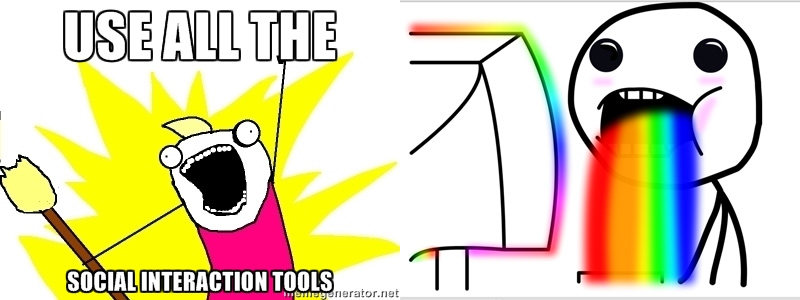Using social media and blogs to enhance social presence – a quick chat with some online educators
 In week two of The #HumanMOOC, participants were encouraged to consider using social media to enhance social presence in online courses, using Twitter as an ideal example. I was sceptical. Like this squirrel.
In week two of The #HumanMOOC, participants were encouraged to consider using social media to enhance social presence in online courses, using Twitter as an ideal example. I was sceptical. Like this squirrel.
There are a few basic steps my organisation takes in online courses to maximise social presence, for example:
- Asking participants to fully introduce themselves
- Making forum participation mandatory to get a certificate (at least 1 post per weekly forum)
- Regularly encouraging the participants in the weekly news posts
- Using volunteers as ‘guest facilitators’ to increase activity in the forums, so participants know they are likely to receive a helpful reply
- Peer learning via peer assessment activities
I’ve also picked up some additional tips via the HumanMOOC, which I mentioned in a previous post.
I’ve heard social media mentioned several times as the most effective way to maximise social presence, but also probably the most difficult. What added value does social media or blogging add to online learning? Shouldn’t we concentrate on improving the interaction within existing forums in the online course? I’d heard much about ‘dual layer’ online learning, but is this combination of different platforms just going to confuse people and discriminate against those people who just don’t want to have to sign up for another social media account? Are we at risk of just throwing technology and tools at problems? Am I being too sceptical of technology?
I was struck by an earlier tweet by one of the courses facilitators, quoting George Siemens:
Dual Layer: Not everyone has the social media literacy to navigate across social spaces external to courses. @gsiemens #HumanMOOC
— Whitney Kilgore (@whitneykilgore) December 5, 2015
In the context of my own work – coordinating online courses for developing country researchers, librarians and journal editors – there are sometimes significant literacy issues: English language literacy, academic literacy and digital literacy. Social media literacy just adds another barrier to overcome – Its difficult enough getting people to interact within a forum without asking students to learn more skills first, especially when they are already pushed for time. For these reasons, social media and external blogging don’t seem very appropriate tools to use. And while Facebook is becoming increasingly popular in developing countries, Twitter is still fairly obscure.
However, many researchers, academics and journalists worldwide do use Twitter, and it does have a lot of potential as a resource – we want to encourage developing country researchers to utilise tools that will give them the ability to communicate their research to a larger audience. Dunlap and Lowenthal (2009)¹ observed that Twitter is great for forcing students to write concisely, and also to be sensitive to the huge audience of an open online community. There is also potential to communicate and get feedback directly from authors and other contacts who they might not be aware are online. xxxx
Blogging also has some potential benefits for practising research writing. My organisation has considered blogging as an internal discussion/collaboration tool, or reflective exercise, but I’m unsure of the benefits of public blogging. Our courses already have (internal) peer assessment activities in which students write a reflection piece and practice writing a research abstract, then get feedback from their peers. Could be an alternative, or compliment this activity? Should the blogging be open and public? That might be an exciting option!
Using the #humanMOOC hashtag I cajoled some online educators and ed tech experts to answer some questions on their experiences of using social media and blogging in their online training. I thought this might also be a good opportunity to test out Storify as a way of recording interesting Twitter discussions:
In summary then:
Twitter:
- Students are not always prepared for using social media in a professional/academic way.
- Twitter can be confusing at first. There is a need to explain it’s particular conventions by way of modelling – using examples, perhaps through Storify (in a more exciting way than the above!), and getting students to share tips.
- There are ways to get students more interested in using Twitter: Embedding a widget to display a Twitter feed in the course, highlighting accounts of known authors and other important accounts – perhaps via pre-create Twitter ‘lists’ (however, they need to sign up to see these).
- Twitter as ‘microblogging’. Some people are nervous of posting things publicly – Twitter could be a first step towards more advanced public writing like blogging.
- The Direct Messaging (DM) functionality in Twitter is a useful tool for directly communicating with people, and for students to communicate with each other.
Blogging:
- Easier to learn and customise for students.
- More popular than Twitter in some contexts – well known as a way of promoting oneself, or showcasing for personal development/CV.
- Public blogging highly motivational as a way of encouraging writing.
- Possible to make into a collaborative activity by use of a ‘hub’ such as Inoreader.
- Some people very nervous about posting their work openly online, while still being a learner and making mistakes.
- In many fields and regulated industries posting publicly might not be a good idea – really depends on context of course/subject/demography
What about developing country researchers?
So now to consider this for the specific context of an online course in research writing for developing country researchers. Would Twitter or blogging be an appropriate component on the course?
Twitter pros:
- Great potential for connecting with other learners and researchers externally
- Ability to communicate with other students informally outside of the confines of the course, or on their own projects
- Twitter is probably the most popular platform for researchers to communicate their work to a global audience, which is an increasingly important aspect of research communication.
- Encourages concise writing – a vital skill required for research communication
- Potential for further collaboration with fellow students once course has finished
- Potential for further content discovery outside course
Twitter cons:
- Not popular or well-known in developing countries
- Could model poor English
- Steep learning curve – unusual conventions
- High level of digital and social media literacy needed – having more than one platform can confuse some people.
- Potentially addictive and distracting
Overall, I think the pros outweigh the cons and there is potential for Twitter to be used in a course for research writing, especially if it is integrated into the structure of the course to show the importance of online research communication and collaboration. It could be argued that this approach is not inclusive, that it requires additional skills that not everybody will have. I think there is a fine balance, but it is arguably more important to offer students the additional skills they need to navigate the social media landscape so they can communicate with an international audience – they can then decide for themselves whether this tool is useful for them long-term.
Some possible Twitter activities for an online course:
- Find at least 5 authors in your field and ‘follow’ them. Retweet at least one tweet that you find interesting (optionally quoting the course hashtag)
- Find 5 journals you would like to publish. Retweet at least one tweet you find interesting, such as recent article or issue.
- Look for educational writing tips, for example via the #acWri hashtag and retweet.
- Connect with at least 5 other students on the course by ‘following’ them.
- Reflect and write about one interesting thing you discovered from the people you follow on Twitter.
- Tweet about an interesting journal article you have read, using a concise summary and linking to the article. If you can find the author on Twitter include their ‘handle’.
- Respond to the weekly question on the course hashtag.
Tasks 1 & 2 could be facilitated by creating list of relevant authors and journals to get them started
In conclusion, there may be potential for using social media with online courses, but with caution – we first priority is providing our students with a simple to understand, low-bandwidth environment which provides good quality learning and social interaction. As long as including Twitter does not distract from this, and is carefully integrated into the course through signposting, how-to guides, modelling, and a clear explanation of the purpose of the exercise; then it has potential to add value to the course – through added social presence, collaboration and content discovery.
Blogging pros
- Excellent for practice writing and reflection.
- Possible to share blog posts with rest of course via hub feed.
- Public posting motivates students to do a good job.
Blogging cons
- Our students tend to know English as their second language, so might not want to share their work publicly if language is not perfect.
- Students may be reluctant to share certain work publicly in case it is copied or reused by others before they’ve had chance to properly write up their work for publication.
- Students may be reluctant to publicly share reflections publicly on certain subjects on our course – publishing ethics, for instance.
I don’t think public blogging currently fits with the online courses we do. Our current research writing course has a ‘peer assessment’ component which has worked very successfully, but the work is not shared with the outside world. I suspect that students would not want to share this kind of work on public blogs, but it may be worth considering for other courses with a more intensive writing focus. There may also be a scope for internal blogging as a reflective exercise, and giving the students the option of blogging this publicly.
¹Dunlap, J. C. & Lowenthal, P. R. (2009). Tweeting the night away: Using Twitter to enhance social presence. Journal of Information Systems Education, 20(2). http://patricklowenthal.com/publications/Using_Twitter_to_Enhance_Social_Presence.pdf


